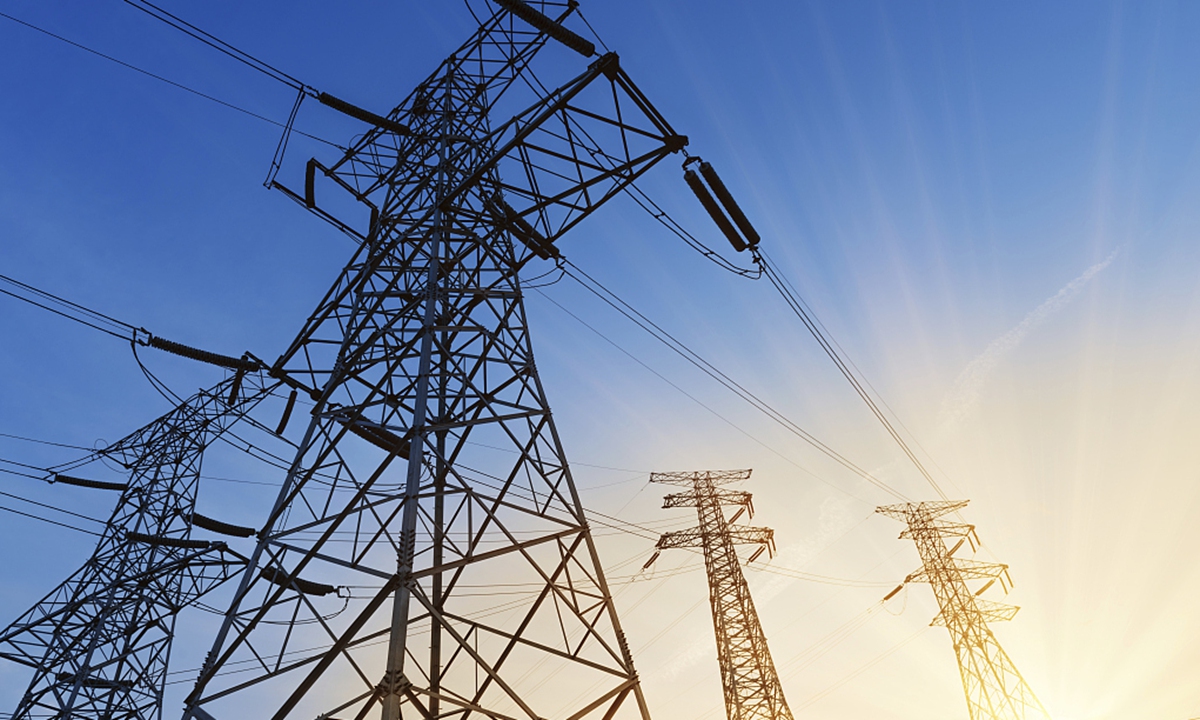
Power transmission lines Photo: CFP
China is scrambling to ensure power supplies with enhanced policy support and expanded domestic and foreign energy sources, as part of an active effort to cope with electricity shortages against the backdrop of soaring coal prices and carbon reduction goals.
While the power curbs in many cities and provinces have posed challenges to some manufacturing industries and daily life, given contingency plans such as diversifying energy supply sources and other policies, the shortages won't become what some Western media outlets have claimed - "an economic or energy crisis."
The recent power cuts caused by high coal prices and tightened supplies have disrupted the daily lives of the people and businesses, ranging from the three provinces in Northeast China to dozens of other areas including East China's Jiangsu Province and South China's Guangdong Province, manufacturing hubs of the world.
Power curbs will also occur in a few neighborhoods in Beijing from Tuesday to October 8, media reports said. A customer service staffer at the State Grid Corp of China (SGCC) confirmed to the Global Times on Tuesday that there will be power cuts in Beijing, which will be the first this year for the capital city.
Due to insufficient supply of coal, the electricity production of power plants has dropped, resulting in the crunch, the employee at SGCC said.
In order to ensure the safe and stable operation of the power grid, some cities and provinces have initiated power curbs in accordance with the orderly power utilization plan approved by the government, according to the employee.
Since the beginning of this year, China's power supplies have faced mounting challenges such as the rapid growth of electricity demand and shortage of coal. Meanwhile, natural factors such as the low inflow of water into major river basins and less wind this year have posed difficulties for the generation of wind and solar power.
In responding to the power shortage, SGCC held an emergency video telephone conference on Tuesday emphasizing that it will go all out to ensure power supply and protect people's livelihood, and it will regard power supply as the most important and urgent political task at present.
Following the sudden power crunch, the governor of
Northeast China's Jilin Province Han Jun paid an immediate inspection tour on Monday to local power plants, and he pledged to release production capacity to the best of his ability.
The efforts include gaining more coal imports from Russia, Indonesia and Mongolia, according to Han.
Currently, Indonesia is China's largest source of coal imports, followed by Russia and Mongolia. Other countries such as the US and South Africa are also seeing a boom in coal exports to China.
From January to August, China's coal imports from the US increased by nearly seven times over the same period last year, and the amount of coal imported from South Africa soared from zero last year to 4.38 million tons, an industry report by cngold.org shows.
However, the volume of imported coal is around 300 million tons, which only takes up about 10 percent of the country's total coal consumption, which is far from adequate to meet the demand for power, Huang Teng, an independent industry analyst, told the Global Times on Tuesday.
"Everyone is now rushing for coal, which has also pushed up the coal price. Thermal coal has now exceeded $200, while it used to be only $20 at the lowest…but it is impossible to find adequate supplies even at such a high price," said Huang.
The high coal prices have discouraged power plants to from increasing inventories or generating more electricity.
A power trader based in South China's Guangdong Province surnamed Zhang told the Global Times that coal inventories are rather low at the moment - about less than a week of capacity.
"The income for power plants isn't high enough to afford expensive coal, which discourages the plants from generating more power," the person said.
The power curbs have sparked global concerns with the "bold" speculation that what happened in some parts of China could even lead to a big fall in the economy.
In a report on Tuesday, Goldman Sachs said that due to energy shortages and sharp cuts in industrial production, it has lowered China's economic growth forecast for 2021 from 8.2 percent to 7.8 percent.
Industry insiders refuted such speculation, saying that China's economy, after having been through the worst of the coronavirus assault and achieved growth as the only major economic power to do so, will not be shattered by temporary power curbs in some regions, given the huge magnitude of the Chinese economy.
Instead, the power cuts will be a reminder to continue the transformation to green development with more clean energy involved in the country's economic boost, experts said.
From 2010 to 2020, the proportion of coal in China's total energy consumption dropped from 69.2 to 56.7 percent, a decrease of 12.5 percentage points, while the proportion of clean energy consumption in total energy consumption increased from 13.4 percent to 24.4 percent.
From a policy point of view, the use of coal, including imported, will be reduced, and China is already moving toward that direction in general terms, but it will take time, Huang said.




